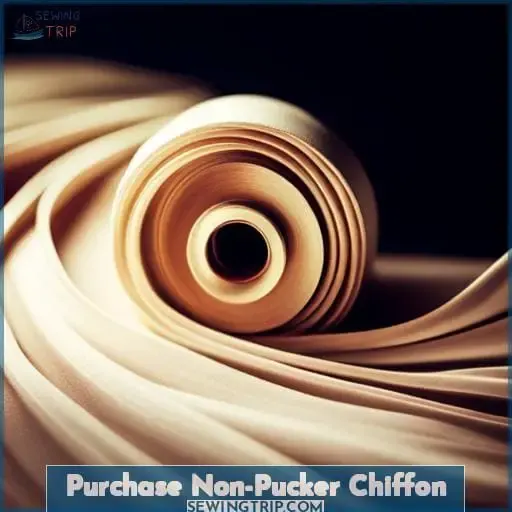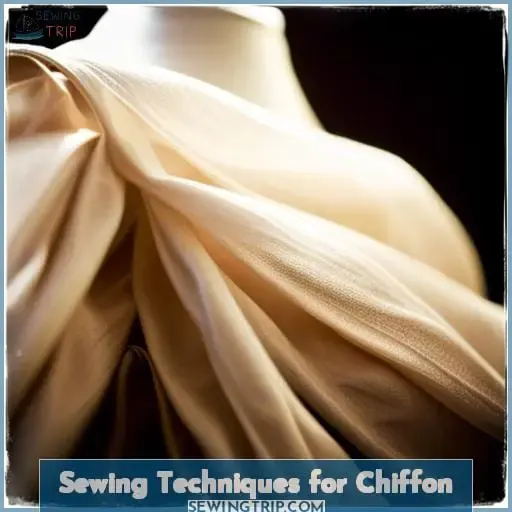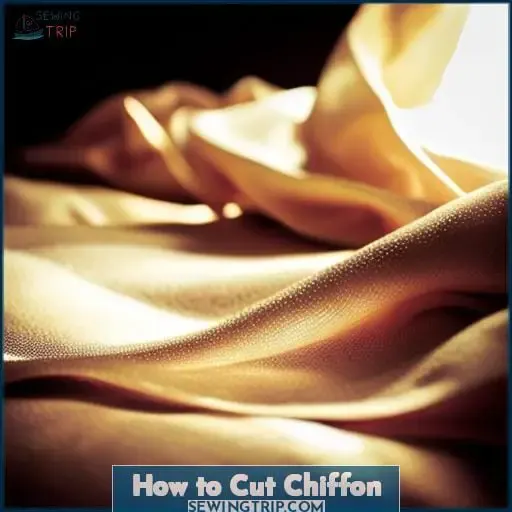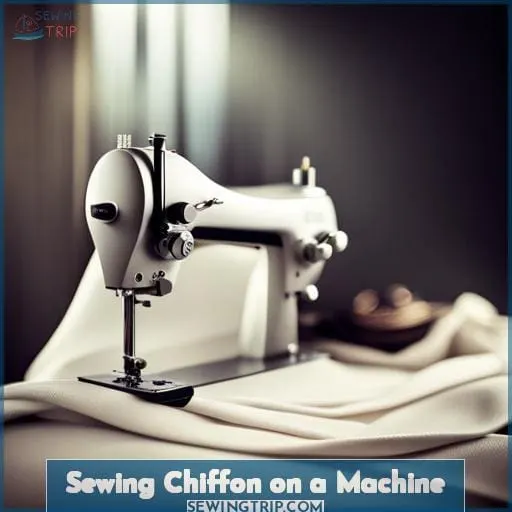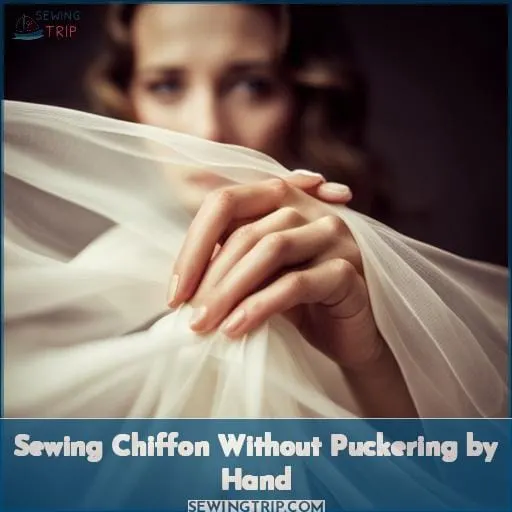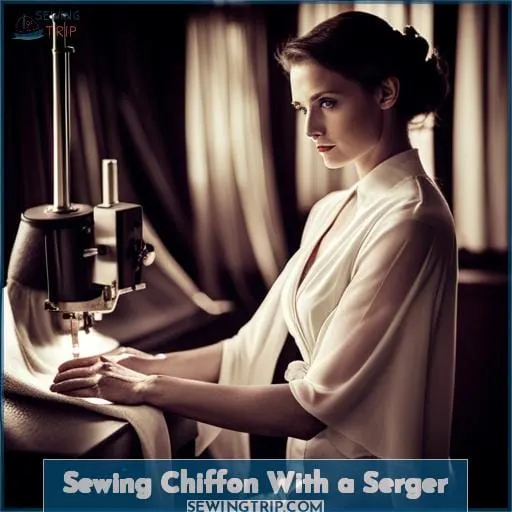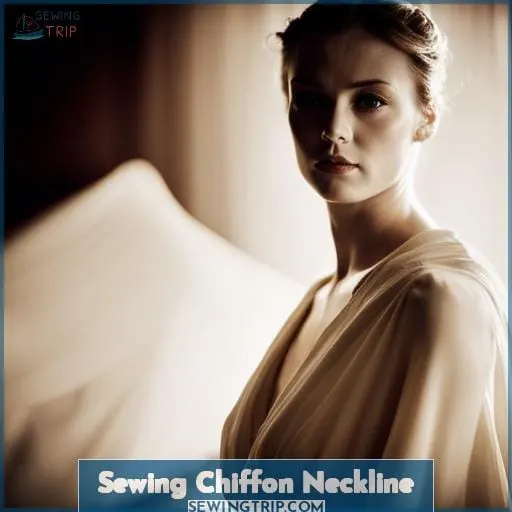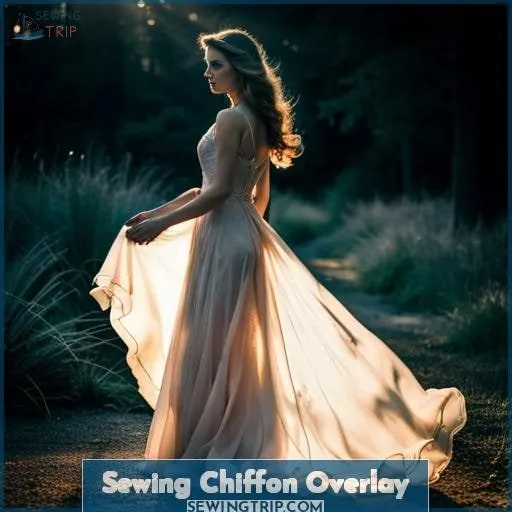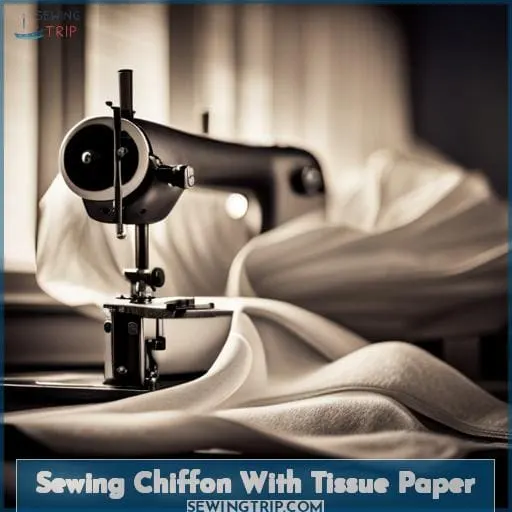This site is supported by our readers. We may earn a commission, at no cost to you, if you purchase through links.
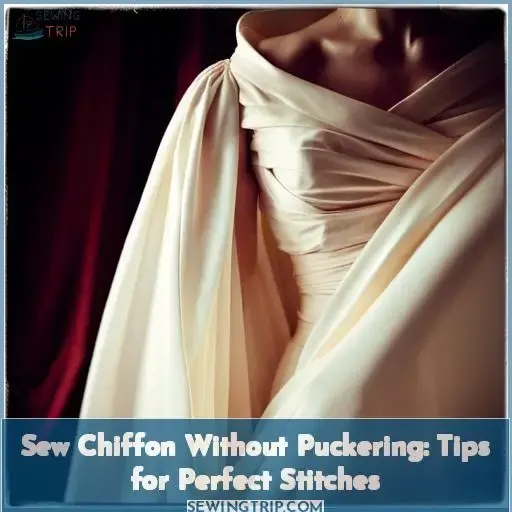 Ah, chiffon. This delicate fabric conjures up images of luxury and grace. However, don’t be fooled – sewing with chiffon can be very challenging! Even experienced sewers often struggle to achieve perfect stitches without puckering.
Ah, chiffon. This delicate fabric conjures up images of luxury and grace. However, don’t be fooled – sewing with chiffon can be very challenging! Even experienced sewers often struggle to achieve perfect stitches without puckering.
If you want to learn how to sew chiffon without puckering, you’ve come to the right place.
Here are some essential tips for flawless results every time:
Select the right needle size. A sharp, fine needle is key to avoiding snags and puckers.
Increase seam allowances. Chiffon tends to fray, so wider seam allowances give you room to work.
Use a fine thread that won’t show through the sheer fabric.
Set your machine to a loose, balanced tension. Too tight of a tension causes gathers.
Cut out patterns single layer instead of folding. Pin pieces carefully.
Use very fine pins that won’t damage the fabric. Place pins perpendicular to the seam.
Stitch slowly and do not pull or stretch the fabric. Let it feed naturally.
Press seams gently with steam. Do not tug or over-iron the finished garment.
Tackle your next chiffon project with confidence! With these simple techniques, you’ll achieve beautiful results with no puckering every time.
Table Of Contents
Key Takeaways
- Choose a non-pucker chiffon fabric with a low polypropylene count.
- Select a small, universal needle (60/8 or 65/9) for sewing chiffon.
- Keep the chiffon taut and wrinkle-free while sewing it on a machine.
- Use French seams for a neat finished look.
Purchase Non-Pucker Chiffon
You’re working with a delicate chiffon that can easily pucker while sewing if not handled properly. To prevent puckering, remember to thread the chiffon over one hand while sewing, gently pushing the thread out of the way and letting the fabric feed through on its own.
Varying your speed and not pulling too tightly can help the fabric glide smoothly. Take care not to tug or hold tension on the fabric. Letting it flow freely as you guide it is key to avoiding puckers with this lightweight material.
Thread the Chiffon Over One’s Hand
Gently tug the slippery sheer chiffon around your hand as you keep the delicate fabric moving. This prevents the chiffon from slipping and shifting while you sew. 1) Position the fabric with the lengthwise grain threads between your thumb and fingers.
2) Slowly slide your hand under the chiffon, keeping it taut but not stretched. 3) Guide the fabric around your fingers, letting it drape loosely. With practice, threading chiffon by hand becomes effortless, ensuring smooth sewing and professional results.
Push the Thread Out of the Way
Hold that chiffon tight and keep the thread ahead of the fabric as you sew. While stitching, gently guide the thread so it lays in front. Letting it trail behind causes tugs and tucks in the delicate chiffon. A light touch and deft hand keeps things smooth.
Managing thread takes practice, but it prevents frustrating puckers. Soon you’ll get the hang of it and sew like a pro, creating flowing garments from slippery chiffon without a pucker in sight.
Repeat on the Other Side
After securing one side, carry the guiding work over to finish off the other.
- Carefully repeat your stitching and techniques from the first side.
- Align and guide the fabric edges in the same manner.
- Take your time for an even finish on both sides.
Having completed the first side, mirror your skills to prevent puckers on the remaining seam.
Press the Chiffon Together
Making a delicate press, align and meld the fabric.
| Grain | Right side | Wrong side |
| Fabric shank up | Fabric shank down | |
| Curl to underside | Curl to top side |
Carefully press open the seam allowance. Use a press cloth, steam, and light pressure to avoid imprinting stitches. Allow ample cooling before moving to prevent heat distortion in the delicate chiffon.
With practice, pressing techniques like adjusting grain alignment and curl direction can prevent puckering in your chiffon projects.
Choosing the Right Fabric
Determining the polypropylene (PP) count and requesting fabric samples are critical first steps when choosing the right chiffon fabric to avoid puckering. As an experienced sewer, you’ll want to examine the PP count — a lower number means less puckering — and don’t purchase without getting a swatch first to test the fabric’s sewing properties.
Determine the Polypropylene (PP) Count
Get the lowdown on the polypropylene count before buying your chiffon, honey, or the fabric gods will smile on you. A fabric’s polypropylene count indicates how much polypropylene is in the fibers. Polypropylene strengthens chiffon but makes it more prone to puckering. Request fabric samples to check the polypropylene content before purchasing.
The lower the polypropylene, the better it’ll sew. Adjust the needle size and tension for the polypropylene level too. And sergers work wonders on low-polypropylene chiffon. Mastery awaits with the right polypropylene know-how, sister.
Request Fabric Samples
Request fabric samples from retailers before purchasing. Swatch samples allow you to test needle sizes, thread types, tension settings, and stitch lengths. Experiment with hand basting since slippery chiffon requires special handling. Selecting suitable materials prevents frustration and ensures your airy chiffon project emerges beautifully without puckers.
Avoid Overstretching Chiffon
Take your time when working with chiffon so the delicate fabric doesn’t tear under strain.
- Handle the fabric gently and avoid tugging or pulling.
- Support areas of the garment with interfacing when needed.
- Allow extra fabric at seams and hem for handling ease.
Patience and care are required when sewing chiffon to prevent overstretching that can damage the wispy, lightweight material. Using proper handling techniques keeps the fabric intact for a beautiful finished garment.
Sewing Techniques for Chiffon
When sewing delicate chiffon, start by using the right needle size, adjusting tension and stitch length, along with a straight stitch needle plate and presser foot. You’ll want to choose a sharp, fine universal needle around 60/8-65/9 to prevent snagging, set your tension slightly looser, shorten your stitch to 12-20 per inch, and use equipment that provides control for the slippery fabric.
Selecting the Right Needle Size
After reviewing the correct needles and tension settings, casually use a size 60/8 needle for your chiffon project, like a friend did when sewing a chiffon wedding dress.
Here’s a quick reference for needle sizes when working with chiffon:
| Fabric | Needle Size |
|---|---|
| Chiffon | 60/8 or 65/9 |
| Lightweight | 70/10 or 80/12 |
| Medium weight | 90/14 |
| Heavy weight | 100/16 |
Selecting the proper needle size for your chiffon sewing project helps prevent puckering and damage. Starting with a smaller, sharper needle and adjusting as needed allows for optimal results.
Adjusting Tension and Stitch Length
Before stitching chiffon, it’s wise to shorten your machine’s stitch length and adjust tensions for the slippery fabric. Test 12-20 stitches per inch and fine threads first. Raise upper tension and lower bobbin tension slightly.
Adjust presser foot pressure down. Check needle plate and foot suit chiffon. Sample sew scraps before your project.
Using a Straight Stitch Needle Plate and Presser Foot
With a steady hand, shift in the straight stitch needle plate and matching presser foot to glide smoothly over the gossamer fabric, keeping its slippery nature from twisting into troublesome tucks.
The straight stitch plate and presser foot balance the fine fabric as it feeds through the sewing machine. Their narrow openings support the sheer chiffon, preventing shifting or scrunching under the pressure of stitching.
Combined with the proper needle, thread, and stitch length, these specialized accessories allow for flawless seams and unleash creative potential. Mastery over temperamental chiffon is within reach with the right tools and a delicate touch.
Considering French Seams or 4-Thread Overedge Stitch
Roll up your sleeves and embrace the elegance of the French seam for a chic, polished chiffon finish.
- Use a presser foot or stabilizer to reduce stretching.
- Keep the fabric smooth and flat when basting.
- Trim the inner raw edge; fold the outer edge in.
- Then fold again to enclose the raw edge on itself.
- Sew parallel stitches for a concealed edge.
Using Pattern Weights Instead of Pins
You’ll find pattern weights work better than pins for securing chiffon while cutting. Pins tend to damage and distort delicate chiffon. Pattern weights feel gentler and safer, while keeping the sheer fabric flat and stable during the cutting process.
With their uniform pressure, weights prevent chiffon from shifting or stretching. Simply position weights on the fabric’s perimeter and corners as needed. They come in various shapes and sizes for custom coverage.
Experiment to find the ideal weights for your project’s chiffon yardage and pattern pieces.
I enjoyed our conversation on sewing techniques for chiffon. Wishing you the best with your fabric projects!
How to Cut Chiffon
When working with delicate chiffon fabric, your cutting tools need to be razor sharp. Carefully cut each piece individually with quality scissors or a rotary cutter to prevent distortion and maintain the integrity of the fabric.
You’ll achieve the best results by keeping the chiffon taut and wrinkle-free while cutting.
To avoid distorting the delicate material, use extra caution when handling and cutting the chiffon. Make clean, precise cuts, taking care not to tug or stretch the fabric. Work on a smooth, flat surface and secure the fabric tightly to prevent slipping and wrinkling during the cutting process.
Sharp shears or an ultra-sharp rotary blade will slice cleanly through the chiffon without snagging or fraying the edges.
Using Sharp Scissors or a Rotary Cutter
Carefully glide the sharp tip of the scissors along the fabric to maintain the pristine edges of your delicate chiffon. Make precise, single-layer cuts to avoid distortion—better to cut one layer than risk stretching all of them.
Allow the blade to do the work with minimal hand pressure. Treat chiffon kindly, whether using shears or a rotary cutter.
Rotary cutters are quick, but scissor tips offer superior precision and control. Master steady hands and gentle pressure; rushed cutting causes mistakes.
Cutting Chiffon Pieces Individually
You can prevent distortion by cutting each chiffon piece separately. I know it takes more time, but it’ll ensure accuracy for your project.
- Lay out the pattern pieces on a single layer of chiffon.
- Use weights or tape to secure the fabric edges.
- Keep the fabric taut and wrinkle-free.
- Cut each piece one at a time with sharp scissors.
Carefully cutting each delicate chiffon piece individually is time-consuming but worth the effort for precise, distortion-free results. Your project will have the elegant drape and flow that chiffon is cherished for when handled with care at each step.
Using Tissue Paper or Stabilizer for Support
Lay tissue paper or stabilizer beneath the chiffon for extra support as you cut each piece. The thin paper helps prevent the slippery fabric from shifting. Stabilizer reinforces the chiffon, giving more structure for clean cutting.
Both act as a barrier between the fabric and your work surface, allowing the scissors to glide smoothly. Maintaining tautness of the layered materials is key. Keep them pulled taut as you cut with care and purpose.
Sewing Chiffon on a Machine
When sewing chiffon on a machine, I keep the fabric as taut and wrinkle-free as possible to prevent puckering. I also enlarge my seam allowances to consider chiffon’s propensity to fray and experiment with shorter stitch lengths of around 1.
5-2.0mm. Additionally, I hand baste my seams prior to permanently stitching them.
Keeping the Fabric Taut and Wrinkle-Free
It’s far-out to keep that delicate fabric smooth and taut while clipping, lest it does catch and tear.
- Use tissue paper underneath.
- Keep edges smooth.
- Weight down gently.
The more gentle handling, the less chance of distorting and damaging. Stay focused and calm while working.
Increasing Seam Allowances for Fraying Tendency
You’ll want to boost those seam allowances when working with chiffon since it frays something fierce. I always add at least half an inch, sometimes more depending on the pattern. That extra fabric helps prevent fraying when you wash it.
If you’re using a serger, dial up the stitch length and trim close to the seam after sewing. Oh, and don’t forget to knot those thread ends securely. That will keep things contained.
Holding the Fabric When Starting and Tying Ends in Knots
Try gripping the delicate chiffon tightly as you start stitching, then tie robust knots at the seamy ends rather than riskily backstitching. Instead of backstitching, which may pucker your chiffon when beginning and ending stitching, firmly clasp the gossamer fabric to start.
Testing Shorter Stitches and Hand Basting Seams
Carefully move the chiffon under the needle as you manually secure the seam before stitching it. When testing stitch length for chiffon, start on scrap fabric first. Experiment with 1.5-2.0 length stitches before sewing the real garment. Hand basting chiffon seams can also prevent puckering by providing flexible securing before the machine stitching.
Evaluating stitch length and hand basting are solutions to avoid seam puckering with this slippery, delicate material. Keep testing settings and techniques, stay patient, and you’ll master sewing chiffon.
Sewing Chiffon Without Puckering by Hand
When sewing chiffon by hand, start with the proper tools. Use a small, sharp universal needle in size 60/8 or 65/9 and fine sewing thread. Also check that your thread and needle tensions are balanced to prevent puckering in the delicate chiffon fabric.
Using a Small Universal Needle (Size 60/8 or 65/9)
Though a microscopic mismatch to the delicate weave, sharpen the pincushion’s ally for smooth sailing through the waves. Scale down your needle, friend. Tiny secrets unlock chiffon’s mystery. Balancing tension takes practice, so baste and test on scraps first.
Needle and thread now embrace the sheer fabric, dancing together in perfect harmony. With care, even handiwork brings an heirloom finish. This shimmering cloth is your canvas; paint your masterpiece stroke by delicate stitch.
Ensuring Proper Thread and Needle Tension
Let’s sew this chiffon without puckering by first fastidiously adjusting your thread tension and needle size for perfection! The slightest mismatch can wreak complete havoc on delicate fabrics. Meticulously adjust the top and bobbin thread tensions per your sewing machine’s manual guidance.
Examine scraps first. Mull utilizing a more delicate thread like silk or cotton. Correspond your needle caliber to the thread thickness. A 70/10 universal for diaphanous chiffon ought to impede skipped fastens and puckering with a shorter fasten length of around 12 fastens per inch.
Avoiding Pulling Chiffon While Sewing
Keep your hands off the fabric as the machine does its job, honey. Let it glide under the presser foot smoothly. Don’t pull or stretch the chiffon as you sew. For best results, use the right needle and proper thread tension to avoid puckers.
Adjust the stitch length to prevent bunching. With practice, you’ll master stitching chiffon without creating gathered seams or ruining the drape.
Sewing Chiffon With a Serger
When working with delicate chiffon, a serger can be a game-changer for preventing puckering. Carefully adjusting the upper, lower, and needle tensions along with using the proper sized sharp needle will allow you to glide through chiffon seams without distortion.
Adjusting Thread Tensions
You’re not exactly smoothing out the wrinkles in your sewing when you can’t adjust thread tensions.
- First check the upper looper, then the lower looper, and finally the needle tension.
- Make small adjustments and retest on scrap fabric after each change.
- Refer to your serger’s manual for the recommended tension settings.
- Note adjustments for future project reference.
With some trial and error on fine-tuning tensions, you’ll soon be sailing through chiffon seams.
Using Proper Needle Sizes
Long, lightweight needles can minimize catching chiffon’s delicate weave in the eye. Pick needle sizes 65/9-75/11 for strong, smooth piercing to keep thread flowing steadily through sheer layers. Sharp points prevent snagging threads as the needle travels up and down. Change needles often; any roughness damages the fabric.
Match the needle size to the thread thickness for the best stitch formation without skipped stitches.
Avoiding Back-and-Forth Sewing at Seam Ends
Tie off your thread ends in knots rather than sewing back and forth when finishing seams on chiffon.
- Secure seams with several tiny hand-tied knots at the end
- Consider using binder clips to hold seam allowances
- Try thread chain stitching to tie off thread tails
- Knot thread right against the fabric edge for a hidden finish
- Experiment with seam sealants if fraying is a concern
Rethink your notions for thread-tying alternatives that maintain the ethereal beauty of your chiffon creation.
Sewing Chiffon Neckline
When working with delicate chiffon, pay close attention to techniques that reduce puckering around necklines. Stay stitch curved edges first to prevent stretching and distortion. French seams encase raw edges for a neat, professional finish without bulk.
Stay Stitching Curved Edges
Stay-stitch those tricky chiffon curves as soon as possible to keep them from stretching out of shape. Take it slow and steady, friend. Make sure your needle is sharp enough for this slippery material.
Stay close to the edge as you go, keeping the tension smooth. That’ll help the seam lay flat once it’s sewn. Your lines will be straight as arrows. Sharp tools are crucial for chiffon’s delicate nature.
Mark lightly too. We’re almost there, just don’t pull and let the machine guide the fabric.
Using French Seams for a Neat Finish
You’re going to love encasing those edges in a French seam for a polished look. Enclose the raw edges within the French seam’s folds for a crisp finish. This technique neatly wraps the fabric’s cut edge twice, preventing fraying. Stitching the seam inside out and then right side out beautifully conceals rough edges in chiffon’s delicate drape.
Achieve seamless elegance with this graceful, couture touch – it finessens your chiffon creations with finesse.
Sewing Chiffon Overlay
When sewing chiffon overlays, support is essential. To prevent puckering and achieve a flawless finish, use tissue paper or stabilizer underneath and opt for French seams wherever possible. You’ll want to place tissue paper or stabilizer under the chiffon to provide support and prevent puckering.
Using Tissue Paper or Stabilizer for Extra Support
You’d laugh at needing stabilizer for chiffon if you tried sewing it freehand.
- Tissue paper prevents slipping.
- Stabilizer adds structure.
- First, sew chiffon to tissue or stabilizer.
- Remove paper after stitching.
The right reinforcement allows your machine to glide through chiffon without puckers. Carefully selecting supportive materials gives your creative expression freedom in this delicate fabric.
Opting for French Seams for a Neat Finish
You’ll achieve a flawless finish by opting for French seams when sewing chiffon. This classic technique fully encloses the raw edges inside the seam. Simply sew the wrong sides together first, then the right sides. It prevents fraying and creates a tidy, professional result.
For hemming, try using a narrow rolled hem foot. Test on scraps first and press gently.
Sewing Chiffon With Tissue Paper
Finicky chiffon requires special handling. To avoid slipping and distortion when cutting, protect your work surface with tissue paper before laying out the fabric pieces.
Protecting Cutting Surface With Tissue Paper
Lay the fabric on tissue paper to stop it from slipping while cutting. The paper creates friction and minimizes shifting.
- Helps the fabric lie flat and wrinkle-free.
- Prevents the delicate chiffon from tearing.
- Allows precise cutting along grain lines.
- Secures pieces during marking and transferring.
- Eliminates the need for pins in most cases.
With this simple trick, cutting chiffon becomes quicker and easier. Tissue paper provides that added bit of control needed when working with such a slippery, lightweight material.
Cutting Chiffon Pieces Individually to Avoid Distortion
Snip each chiffon piece separately so it won’t stretch out of shape before sewing. Chiffon’s lightweight nature makes it prone to distortion. Cutting each section individually prevents the delicate fabric from shifting as you cut.
This precise approach keeps the grain straight and the pieces uniform. With practice, you’ll master chiffon’s temperamental tendencies for exquisite transparent creations.
Conclusion
Many people find chiffon a tricky fabric to sew because of its tendency to pucker. But with the right equipment, knowledge, and techniques, you can sew chiffon without puckering. Start by purchasing a non-pucker chiffon fabric. Check the polypropylene count and request fabric samples.
Use a small universal needle (60/8 or 65/9) and adjust the tension and stitch length. Cut the fabric carefully with sharp scissors or a rotary cutter. Sewing chiffon on a machine requires keeping the fabric taut and wrinkle-free, increasing seam allowances, and holding the fabric when starting and tying ends in knots.
Sewing chiffon by hand needs correct thread and needle tension. And a serger requires proper thread tensions and needle sizes. For a neat finish, choose french seams, stay stitch curved edges, and use tissue paper or stabilizer for extra support.
With the right tools, techniques, and patience, you can create beautiful chiffon garments without worrying about puckering.

